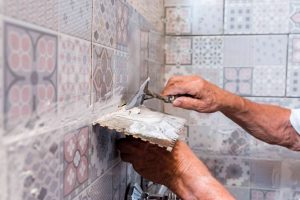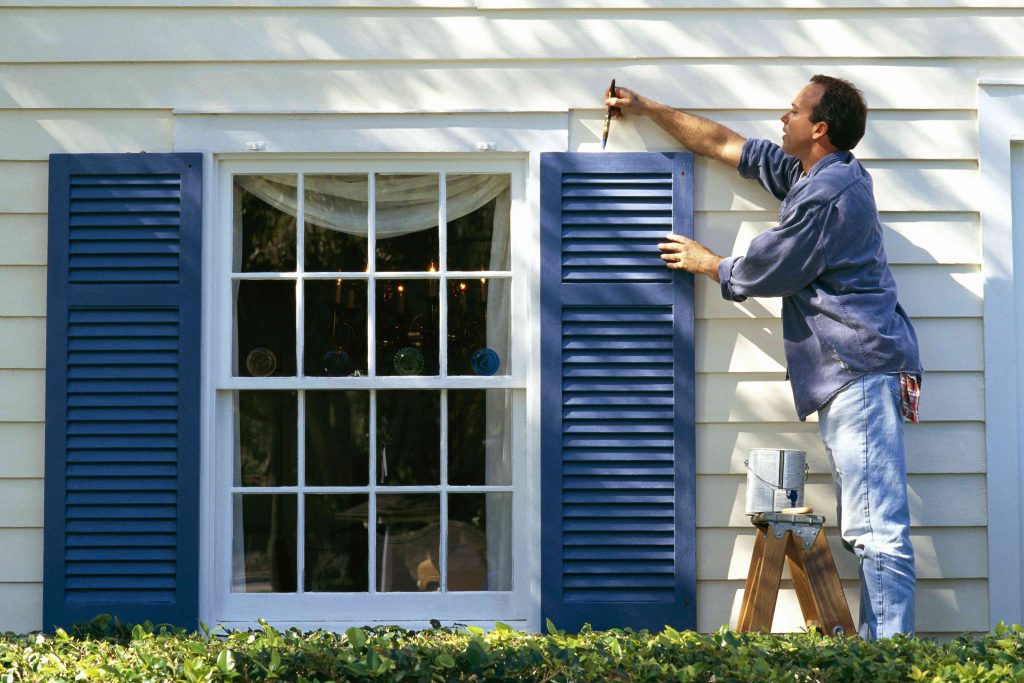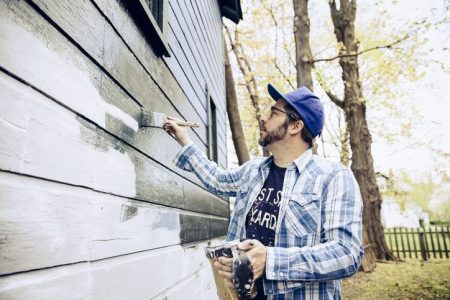Decorative and functional shutters are commonly installed on either side of a home’s windows in order to introduce new colors to the aesthetic and improve the exterior appearance of the home. However, over time the shutters can fade, chip, or peel, leaving the home looking aged and bland. To help update the appearance of a home’s exterior, vinyl shutters can be painted a new color or renewed with a fresh coat of the same color paint.
Using Primer on Vinyl Shutters
Primers are commonly used for exterior painting in order to seal the original material, hide joints, and cover seams. If the vinyl shutters show signs of deterioration, severe weather damage, or pitting, then it may be a good idea to use a primer in order to seal these imperfections and provide a good base for the paint. Primer isn’t necessary for vinyl shutters that are in good condition, because the paint will adhere to the vinyl surface without any problems.
Before You Begin
Before beginning, it’s a good idea to prepare a work area that can be blocked off to prevent accidents caused by passing individuals, like kicking over the paint bucket or hitting the ladder.
One of the best ways to quickly and effectively paint vinyl shutters is to simply remove them from the home and set up a painting workstation in a well-ventilated garage, shed, or outdoor location.
Vinyl shutters are typically installed with either metal mounting clips or plastic mounting nails. If the shutters are installed with metal mounting clips, they are relatively easy to lift off, but if they are installed with plastic mounting nails, it may be better to paint them in position. Before starting, inspect your type of shutters and decide on the best approach to the project.
If you prefer to paint the shutters in place, then you will need to use painter’s tape around the edges of the shutters to avoid painting the sides of the home or the windows.
Safety Considerations
Make sure to wear appropriate personal protective equipment (PPE), including eye protection, gloves, and closed-toe shoes. A protective mask is also a good idea if you will be painting the shutters in an enclosed location, like a garage or workshop.
Keep in mind that not every set of shutters is located on the first floor, so you will need to take proper precautions while working on a ladder or on the roof to reach the vinyl shutters on the second floor. Assign a spotter to keep the ladder steady and consider wearing a harness that can be tied off in order to help prevent accidental falls. If you’re not comfortable climbing high on a ladder, consider hiring a professional painting service.
What You’ll Need
Equipment / Tools
- Garden hose
- Soft-bristle brush
- Microfiber cloth
- Paint brush
- Hacksaw
- Pliers
- Drop cloth
- Caulking gun
- Ladder
- Safety gloves
- Safety glasses
- Breathing protection
- Bucket
Materials
- Soap
- Painter’s tape
- Plastic mounting nails
- Silicone caulking
- Primer (optional)
- Latex exterior paint
Instructions
-
Remove the Vinyl Shutters (Optional)
If the shutters are secured with metal mounting clips, simply move around the house and lift the vinyl shutters off of their mounting clips.
For shutters that are installed with shutter loks, pull the vinyl shutter about an inch away from the wall in order to use a hacksaw and cut through the shutter loks.
After cutting through the plastic mounting nail to free the shutter, it’s important to use pliers to remove the remaining pieces of plastic mounting nails and fill the holes with silicone caulking. This helps to protect the home from insect infestations and water damage, while also preparing the area for the reinstallation of the vinyl shutters.
-
Clean the Vinyl Shutters
Whether you removed the shutters or not, they need to be properly cleaned with soap, water, and a soft-bristle brush to ensure that the paint will adhere to the smooth, clean surface. Use a hose and a bucket of soapy water to wash and rinse the vinyl shutters, allowing them to dry before proceeding. A clean microfiber cloth can be used to wipe up excess water in order to speed up the drying process.
-
Prepare the Area Before Painting
Before painting, check to make sure that the primer and paint will not get on the side of the home, a window, or drip onto the roof or floor. If the vinyl shutters have been removed, lay down a drop cloth that covers the entire area to protect the workbench and floor. For vinyl shutters that are still in position, remember to tape around the shutters and to lay down a drop cloth below the shutters to catch any stray drops that may fall.
-
Prime and Paint the Vinyl Shutters
After cleaning the shutters, it should be relatively easy to determine whether they need a coat of primer before painting or if the surface of the vinyl shutters is smooth enough to be painted without a primer. Remember that any severe deterioration, weathering, or pitting is a sign that the vinyl shutters should be primed before painting.
Due to the slats that are common on vinyl shutters, rollers are not a good option. Use a paintbrush to apply even coats of primer, if necessary, and allow it to substantially dry according to the manufacturer’s recommendations. This typically takes between one to four hours before the shutters can be painted.
Once the primer is dry, the shutters are ready to be painted. Exterior latex paint is the best choice for vinyl shutters due to its high UV resistance and good adhesion to vinyl. Use a paintbrush to fully coat each shutter, ensuring a thick, even distribution of paint. This type of paint typically dries to the touch in about two hours but can take up to 48 hours to fully cure.
-
Reinstall the Vinyl Shutters
If you removed the vinyl shutters, then they will need to be reinstalled after the paint has fully dried and cured. This should be fairly easy if the shutters were originally installed with metal mounting clips. Simply hook the shutters onto the clips and slide them into place.
If the shutters were installed with plastic mounting nails, then you will need to drill new mounting holes and install the shutter lok fasteners by inserting them through the holes in the shutter and tapping the fasteners with a hammer to drive them into the wall for a snug fit. Just make sure that the hole is the appropriate size so that the shutter lok fasteners will grip the sides of the hole and prevent the shutters from moving.
Read the full article here














